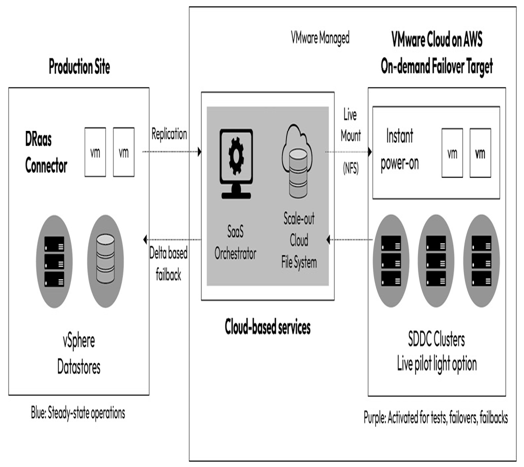VCDR is a DRaaS provided by VMware. VCDR enables protection of on-premises vSphere environments and VMware Cloud on AWS SDDC by using an innovative concept of zero-compute DRaaS solutions. The main component of VCDR is the Scale-Out Cloud File System (SCFS) deployed in AWS Cloud. SCFS provides the ability to store large amounts of data efficiently and effectively, with hundreds of recovery points. You can replicate entire VMs with a recovery point objective (RPO) as low as 30 minutes. The SCFC facilitates storage of data during normal operations of your production sites. If the infrastructure needs to be restored, VCDR uses VMware Cloud on AWS SDDC to register VMs and start the environment.
The following figure depicts the high-level architecture of VCDR:

Figure 3.14 – VCDR replication architecture
The main goal of VCDR is to simplify DR protection, reduce costs, and orchestrate the recovery. However, the main advantage of this service is flexibility – with different deployment options, organizations can choose between the speed of recovery and costs of the solution. VCDR supports the following deployment options:
- Just-in-time deployment: When opting for this option, no VMware Cloud on AWS SDDC exists during normal operations. When the infrastructure needs to be restored, VCDR first will initiate the creation of the SDDC using the predefined configuration. Once the deployment completes, VCDR will mount the SCFC datastore and bring the VMs online. This option is the most cost-effective but increases the RTO, and it requires the IT team to perform certain tasks to finalize the SDDC configuration, before the environment is ready to be used.
- Pilot-light deployment: To shorten the RTO, organizations can opt to pre-deploy an SDDC in the minimal configuration – with just two hosts. The ability to pre-deploy the SDDC helps you to fulfil most of the configuration tasks beforehand – establish connectivity to the vCenter Server, add connectivity to on-premises, and pre-deploy a vital infrastructure service (Active Directory, DNS, DHCP, etc). You can also use the SDDC to run other workloads if needed. If the failover is required, VCDR will inflate the pilot light SDDC by adding hosts using rapid-scale in policy, with up to 12 hosts in parallel. This option helps to shorten the RTO and minimize the configuration work required to bring the VMware Cloud on AWS SDDC to production. Conversely, you will need to pay for the pilot light deployment under normal operations.
- Ahead-of-time deployment: You can opt to pre-deploy a full environment beforehand. All the compute capacity is instantly available in case of failover. You still can use the capacity of the SDDC to run other workloads if required. This option has the best RTO but comes with the highest costs.
Which option you choose depends on organization requirements, the desired RTO/RPO, and the available budget. Pilot-light deployment is recommended for all organizations protecting an on-premises workload – with this option, you can make sure that your recovery platform is fully ready to accommodate production workload ahead of time.